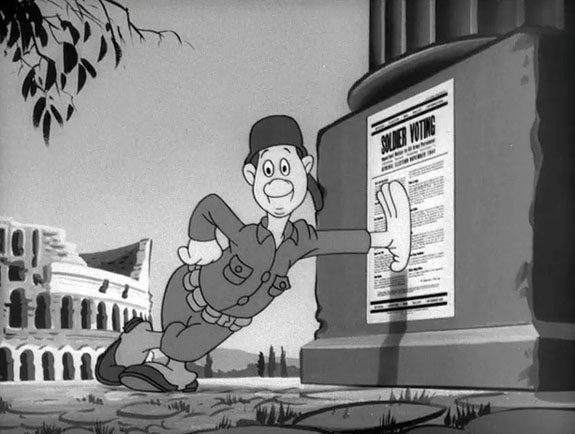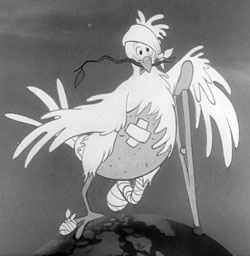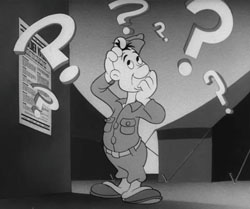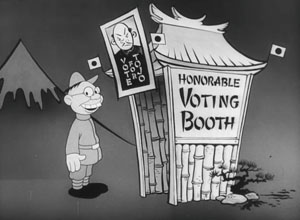
With Thunderbean ‘world headquarters’ moving out of the basement here and into an actual office, I’m finding time to work a little more on the titles for this year. As we’re working on the Snafu Blu-ray, I’ve been looking through all the materials that were transferred on the Army/Navy Screen Magazine, some with Snafu in them, some without. These were all transferred in HD, so we’re dusting them off for the Snafu blu-ray set. Right now, I’m debating putting ALL the Army/Navy Screen Magazine animation on the Snafu set (even the Non-Snafu episodes) or having an HD version of the ‘Cartoons for Victory‘ materials with these. What do you folks think would be best?
 The two shorts I’m discussing this week were produced by the Disney Studio, and were among the harder to see of the war films made by the studio. They remain, as so many war shorts, interesting looks back into history more than having great entertainment value. I was happy to be able to transfer them from the 35mm materials (both of these from the Fine Grain Master Composties) at the United States National Archives. Both appear on the ‘More Cartoons for Victory‘ DVD from a few years back.
The two shorts I’m discussing this week were produced by the Disney Studio, and were among the harder to see of the war films made by the studio. They remain, as so many war shorts, interesting looks back into history more than having great entertainment value. I was happy to be able to transfer them from the 35mm materials (both of these from the Fine Grain Master Composties) at the United States National Archives. Both appear on the ‘More Cartoons for Victory‘ DVD from a few years back.
These films were more than likely designed & storyboarded at the First Motion Picture Unit, comprised of artists from various studios. Because they were produced as past of the Army/Navy Screen Magazine, they don’t have the usual Disney credits on them. Both are fairly dry, concentrating on the information at hand. It would be great to see the original storyboards on both these shorts for comparison to the studio’s styling. One short on the More Cartoons for Victory, “Weapon of War”, was boarded at FMPU beautifully; what appears in the animation from UPA is virtually identical in design and composition.
 I hope to head the National Archives again sometime soon to look for various materials. I’ve promised a friend that I would try to track down things on his longtime list of want-to-sees..
I hope to head the National Archives again sometime soon to look for various materials. I’ve promised a friend that I would try to track down things on his longtime list of want-to-sees..
The first here, Another Chance (1944) is barely animated- almost all stills. It explains how the newly founded United Nations works, and why. It’s a fairly straight forward explanation to the troops on the formation of the United Nations. It’s understandable why this particular film was handled in animation/graphics: it does a good job of explaining simply many ideas that would be hard to show in any other way.
 Voting for Servicemen (1944) was included as a special addition to the Army/Navy Screen Magazine to help the service men and women understand how they could vote while overseas, how the system works and why it’s important. It’s funnier at the beginning especially, and interestingly similar to the format of the educational Disney films to come in the future. It’s a good explanation of how the voting process works for service people.
Voting for Servicemen (1944) was included as a special addition to the Army/Navy Screen Magazine to help the service men and women understand how they could vote while overseas, how the system works and why it’s important. It’s funnier at the beginning especially, and interestingly similar to the format of the educational Disney films to come in the future. It’s a good explanation of how the voting process works for service people.
The production, even with a limited budget, is top notch, with excellent design and execution of graphics especially. To me, it’s interesting to see how the Disney Studios animated Snafu, but also odd to see several different art styles unitized in the same film. Some of the posing is quite nice, while other poses / expressions are not as well drawn.
The lack of these particular films showing up in 16mm war prints is understandable. These were some of the later films produced for the war, and more than likely only appeared once in the Army/Navy Screen Magazine. Because they arn’t as entertaining as the Snafu shorts, it makes some sense that the were not kept.
That’s the report from Thunderbean-Land for now. Have a good week everyone!


 Steve Stanchfield is an animator, educator and film archivist. He runs Thunderbean Animation, an animation studio in Ann Arbor, Michigan and has compiled over a dozen archival animation DVD collections devoted to such subjects at Private Snafu, The Little King and the infamous Cubby Bear. Steve is also a professor at the College for Creative Studies in Detroit.
Steve Stanchfield is an animator, educator and film archivist. He runs Thunderbean Animation, an animation studio in Ann Arbor, Michigan and has compiled over a dozen archival animation DVD collections devoted to such subjects at Private Snafu, The Little King and the infamous Cubby Bear. Steve is also a professor at the College for Creative Studies in Detroit.






















Great post! I didn’t know the Disney Studios ever animated Snafu.
Was that Mel Blanc doing the voice of Hitler?
Hi Steve,
Sounds like another great set. However, I don’t have the “Cartoons for Victory” sets, yet — so I’m a bit confused as to what our two choices are. I really enjoyed to two cartoons in your post, and would love to see more of the same. I’m sure I’d be interested in the “Cartoons for Victory” sets, too. Can’t you just add them all to the blu-ray set? 😉
Oh yeah, that’s Mel doing Adolph.
Thanks for another great Thunderbean Thursday, Steve.
To answer your question, I’d prefer the Snafu Bluray to exclude the drier non-Snafu material, but I can understand requests to include as much of this rare material as possible.
What I would like to see on the Snafu would be the Hook shorts, including the lone Walter Lantz entry.
Unfortunately, we’re SOL on the Hook cartoons. They were only ever transferred in SD, and the prints themselves have disappeared. If anyone knows the whereabouts of 16mm or 35mm material on the Hook cartoons, please let us know!
I wasn’t familiar with these films so I looked them up in my master list of Disney productions. I did find “Another Chance” which is also listed as “U.N. Peace Charter” with a release date of 1945. I couldn’t find anything though for “Voting for Servicemen”. Is there anything that definitely would show that this came from Disney?
It’s listed in Shale’s famous book “Donald Duck Joins Up”:
1944: A Few Quick Facts #6 [Soldiers Voting Overseas] (for U.S. Army)–5 min. (Prod. 4016)
The log records at the National Archives show the productions and the production company for each of the segments in the Army/Navy Screen Magazine- this is where I found the information on these shorts.
In 1944 Disney did “A Few Quick Facts #7 (Venereal Disease)”, production number 4016. That’s the only entry I can find for them in the “A Few Quick Facts” series. So the right production number to match Shale, then, but a completely different title. My data comes from Dave Smith’s “Supplement to All Pictures Book” and is consistent in each version I have.
Here’s a list of the Disney WWII shorts based on Dave Smith’s files:
1942
Icing Conditions (Navy)
US Army Identification Series – WEFT and Warships (Navy)
US Army Identification Series – WEFT (Navy)
Protection Against Chemical Warfare (Navy)
Prelude to War (Army)
Know Your Enemy, Germany (Army)
Forming Methods (Navy)
Boys Anti-Tank Rifle [Stop that Tank] (National Film Board of Canada)
Blanking and Punching (Navy)
Bending and Curving (Navy)
Battle of Britain (Army)
Approaches and Landings (Navy)
Out of the Frying Pan Into the Firing Line
Aircraft Carrier Mat Approaches and Landings (Navy)
Aircraft Carrier Landing Signals (Navy)
Food Will Win the War
The Nazi’s Strike [Campaign in Poland] (Army)
Aircraft Riveting (Navy)
Donald’s Decision
All Together
The New Spirit
1943
Battle of China (Army)
Battle of Russia (Army)
Basic Electricity
British Torpedo Plane Tactics (Navy)
Aeronca Project [Basic Maintenance of Primary Training Airplanes] (Army and Aeronca)
C-1 Autopilot
Carrier Rendezvous and Breakup (Navy)
The Cold Front (Navy)
Divide and Conquer (Army)
Beechcraft Maintenance and Repair (Beech Aircraft Corp. and Army)
The Aleutian Islands [A.D.C. Project] (Army)
Aircraft Welding (Navy)
Aircraft Carrier Landing Qualifications (Navy)
Air Masses and Fronts (Navy)
Der Fuehrer’s Face
Education for Death
Fog (Navy)
The Spirit of ’43
Reason and Emotion
Chicken Little
Air Transport Command (Navy)
Template Reproduction (Navy)
Fast Company (Army)
Fixed Gunnery and Fighter Tactics (Navy)
The Warm Front (Navy)
Thunderstorms (Navy)
Substitutions and Conversion (Army)
Rules of the Nautical Road (Navy)
The Occluded Front (Navy)
Mock-Up and Tooling (Navy)
The Mark 13-Modification I Aerial Torpedo (Navy)
Lofting and Layouts (Navy)
Know Your Enemy – Japan (Army)
High Level Precision Bombing (Army)
Heat Treating (Navy)
Minnepolis Honeywell Project [Auto Pilot] (Army)
V.T.B. Pilot Training (Navy)
Glider Training (Army)
1944
Weather at War (Navy)
Howitzer,105mm M2A1 and Carriage M2, Principles of Operation (Army)
It’s Your War, Too (Army)
Operation and Maintenance of the Electronic Turbo Supercharger (Army)
Theory of Simplex and Phantom Circuits (Army)
Your Job in Germany (Army)
Tuning Transmitters (Army)
Ward Care of Psychotic Patients (Army)
Weather for the Navigator (Navy)
The Howgozit Chart (Navy)
Battle of Cape Gloucester (Army)
Two Down and One to Go (Army)
Automotive Electricity for Military Vehicles (Army)
The Case of the Tremendous Trifle (Army)
Attack in the Pacific (OWI)
Fundamentals of Artillery Weapons (Army)
Basic Map Reading (Army)
Carburetion, Basic Principles (Army)
Electric Brakes, Principles of Operation (Army)
The Equatorial Front (Navy)
A Few Quick Facts #7 [Venereal Disease] (Army)
Flying the Weather Map (Navy)
Air Brakes, Principles of Operation (Army)
1945
War Comes to America (Army)
Another Chance [UN Peace Charter] (Army)
Burma Campaign [The Stilwell Road] (Army)
Dental Health (Army)
On to Tokyo (Army)
Regards
Bill
Hi Bill,
The next time I’m at the National Archives I’ll pull the production information again. They also showed ‘GI Bill of Rights’ (1946) was s Disney production too… and is one of the the last appearances of Private Snafu. I wouldn’t have known this was a Disney production without that information. On ‘Voting for Servicemen’, besides the information at NARA, other production aspects point to the studios’s work in music, sound effects and production. On Here’s the post from last year on ‘GI Bill of Rights’. It appears that this film also had a very low budget, down to Snafu’s drawing style nearly matching the boards.
https://cartoonresearch.com/index.php/gi-bill-of-rights-1946/
The list in Shale’s book is MUCH longer. He lists two “A Few Quick Facts”-films:
1944:
A Few Quick Facts #6 [Soldiers Voting Overseas] (for U.S. Army)–5 min. (Prod. 4016)
A Few Quick Facts #7 [Venereal Disease] (for U.S. Army)–3 min. (Prod. 4016)
As both films have the same production number, it seems as they were made at the same time. But “Venereal Disease” is still a mystery, as nobody seems to have a copy…
Its unfortunate that Shale’s book is long out of print so the information in Shale’s book are not widely available Appendix C in particular which list all of these Army, Navy Training films. If anyone has the book it wouldn’t be unwise I think if some one listed up all the differences between shale and infos from Dave Smith.
Is that Ronald Reagan narrating?
I think the narrator is Bill Goodwin, who was the announcer for Burns and Allen.
I’d love to learn the economics involved with these release. i.e the llicensing rate for a bluray vs. a DVD. Wouldn’t it cost more to include a second disk even if it was a DVD than to dump them at the end of a bluray as “bonus material”?
I say, let’s just do everything at the highest bit rate that a 35mm frame could possible require and get this done with once and for all. I can’t imagine how Criterion breaks even on their releases; how Thunderbird manages it with such obscure – but important – titles is beyond me. But I am so glad you do.
Well, I guess I would agree with the first posting that wishes that all such material–the SCREEN MAGAZINE *AND* the two volumes’ worth of CARTOONS FOR VICTORY–end up on the expanded PRIVATE S.N.A.F.U. collection, but I could also live withan expanded PRIVATE S.N.A.F.U. collection that also includes all the HOOK shorts *AND* perhaps “TOKIO JOKIO”, “BUGS BUNNY NIPS THE NIPS” and, maybe, even “HOP AND GO”, if it is in the public domain. I almost wish that you could talk Warner Bros into cooperating with such a project so you could get really nice prints of *ALL* their wartime cartoons, both for the soldiers and as homefront cartoons, so you could get stunning print quality, but hey, the S.N.A.F.U. set alone, previously, had some fascinating things. But, again, the HOOK shorts need to be included.
Yay! And I vote for two sets.
Put as much cool stuff on it as you can (especially if it wasn’t on the original DVD set). I will buy it again on Blu Ray.
I’m looking forward to this release. As for what you include in the release, do whatever you decide is best. Given my experiences with Thunderbean titles, I trust your judgement without hesitation. Whatever you do, I’m certain this will be a great release.